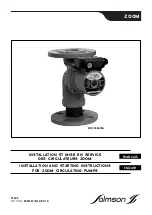
3B
For units utilizing V-belt drives, make sure the
sheaves are properly installed and aligned
before attempting to tension the drive. The V-
belts should be placed over the sheaves and
in the grooves without forcing them over the
sides of the grooves. The tensioning steps 1,
2, 3 and 4 can be used for all types of V-
belts, all cross sections and number of belts
and all types of construction.
Avoid
excessive heat
(140
o
F and higher);
belt life will be shortened.
Never
switch
or
mix
belts
from one groove to another on the
sheaves.
Do not use belt dressing.
Sheaves
should remain free of oil and grease.
When
replacing belts install an identical set.
For more specific V-belt tensioning guidelines
consult factory.
1. With all belts in their grooves, adjust
centers to take up the slack until they are
fairly taut. Use standard V-belt tensioning
guidelines.
2. Start the drive and continue to adjust until
the belts have only a slight bow on the
slack side while operating
with
load
conditions.
3. After several days of operation, the belts
will seat themselves in the sheave
grooves. Further tensioning may be
necessary to the point that the drive
shows a slight bow in the slack side.
Insufficient tension is often evidenced by
slipping (squealing) at start-up.
4. If the unit is idle for an extended period of
time, the tension on the belts should be
removed.
4
Check fluid level in separator reservoir. The
fluid level should be at the FILL LINE on the
sight gauge. Add oil if necessary.
5
If your system contains an inlet valve, set it to
approximately 3/4 closed, and start pump. If
valve is not supplied, one should be installed.
6
Run the pump for a few minutes, then turn it
off.
7
With the pump shut off, check fluid level
again. The fluid level should be at the FILL
LINE on the sight gauge. Add fluid if
necessary.
Warning: never remove the oil fill plug
while the pump is running.
8
Start pump again and check that discharge
pressure on the separator pressure gauge
does not exceed 2 psig when operating under
vacuum conditions. A pressure higher than 2
psig is a sign of high back-pressure in the
discharge pipe system. Pressure gauge might
show a higher pressure at start-up at low
vacuum (0-10" Hg).
Dekker Vacuum Technologies, Inc. – Vmax/13
9









































